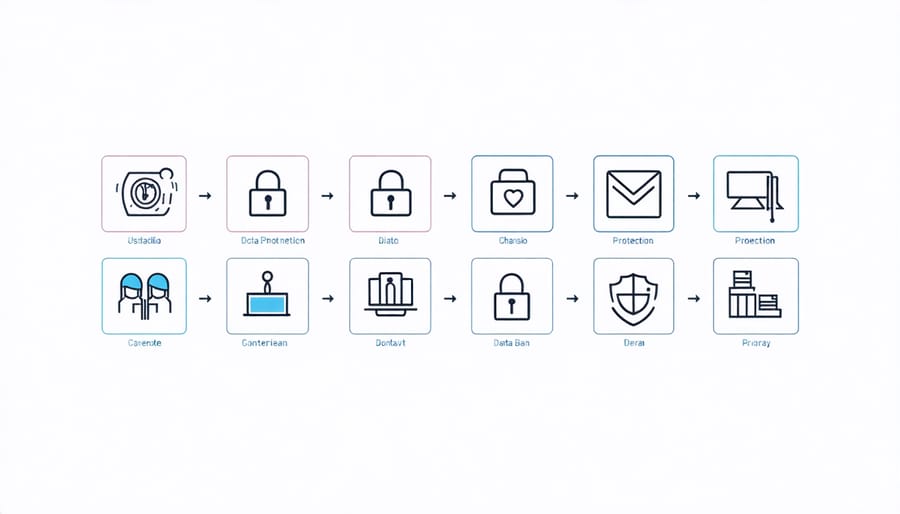Navigating Canada’s healthcare regulatory landscape demands strategic preparation and unwavering compliance commitment from business owners and healthcare providers. Recent regulatory changes, including enhanced privacy requirements and digital health innovations, have transformed how healthcare organizations operate in the Canadian market. Understanding these evolving regulations isn’t just about compliance—it’s a critical business driver that impacts patient care quality, operational efficiency, and financial sustainability.
Healthcare organizations must adapt to stringent compliance requirements while maintaining service excellence. From small medical practices to large healthcare networks, stakeholders face complex challenges in meeting federal and provincial regulations, managing risk, and implementing effective governance structures. The regulatory framework encompasses patient privacy protection, facility accreditation, professional licensing, quality assurance protocols, and emerging technologies integration.
This dynamic regulatory environment creates both challenges and opportunities. While compliance demands significant resources and expertise, organizations that successfully navigate these requirements often gain competitive advantages through improved operational efficiency, enhanced patient trust, and reduced legal risks. Forward-thinking healthcare providers are leveraging regulatory compliance as a catalyst for organizational excellence and sustainable growth in Canada’s evolving healthcare landscape.
Key Healthcare Compliance Requirements for Canadian Businesses
Employee Health and Safety Standards
Employee health and safety standards in Canadian healthcare settings are governed by both federal and provincial legislation, establishing comprehensive requirements to protect workers and patients alike. Healthcare facilities must maintain strict protocols for infection control, proper handling of medical equipment, and management of hazardous materials.
A key component is the implementation of workplace safety programs that include regular staff training on proper lifting techniques, handling of sharp objects, and exposure to biological hazards. These programs typically incorporate emergency response procedures and protocols for reporting workplace incidents.
Personal protective equipment (PPE) requirements are particularly stringent in healthcare settings. Facilities must provide appropriate PPE, including gloves, masks, gowns, and eye protection, while ensuring staff are properly trained in their use. Regular assessments of workplace hazards and updating safety protocols accordingly are mandatory.
Mental health support has become increasingly emphasized, with many facilities implementing wellness programs and stress management resources. As noted by the Canadian Centre for Occupational Health and Safety, healthcare workers face unique psychological challenges that require specific support systems.
Regular workplace inspections, documentation of safety procedures, and maintenance of emergency equipment are essential components of compliance. Healthcare facilities must also establish clear communication channels for reporting safety concerns and maintain detailed records of workplace incidents and resolutions.
Successful implementation of these standards requires ongoing commitment from management and active participation from all staff members. Regular reviews and updates of safety protocols ensure continued effectiveness and compliance with evolving regulations.
Privacy and Data Protection Mandates
In Canada, the Personal Information Protection and Electronic Documents Act (PIPEDA) sets the foundation for healthcare data protection and privacy requirements. Healthcare organizations must obtain informed consent before collecting, using, or disclosing personal health information, while ensuring this information remains secure and accessible only to authorized personnel.
Healthcare providers must implement robust security measures to protect patient data, including encryption of electronic records, secure physical storage for paper documents, and strict access controls. Regular staff training on privacy protocols and documentation of all data handling procedures are essential components of PIPEDA compliance.
Organizations must also establish clear policies for data retention and disposal, maintaining records only as long as necessary for the identified purpose. In the event of a privacy breach, healthcare providers are required to notify affected individuals and the Privacy Commissioner of Canada.
Provincial variations exist, with some provinces having their own health information privacy legislation that takes precedence over PIPEDA. For example, Ontario’s Personal Health Information Protection Act (PHIPA) provides specific guidelines for healthcare providers operating within the province.
Dr. Sarah Thompson, Privacy Commissioner at Toronto General Hospital, emphasizes: “Maintaining patient trust through proper data protection isn’t just about compliance – it’s fundamental to delivering quality healthcare services in the digital age.”
To ensure compliance, organizations should conduct regular privacy impact assessments and update their protocols to address emerging technological challenges and evolving privacy threats.

Cost Implications and Financial Planning

Budget Considerations
Maintaining compliance with healthcare regulations requires careful financial planning and allocation of resources. According to the Canadian Healthcare Association, organizations typically spend between 6-12% of their operational budget on regulatory compliance activities.
Key cost components include staff training and development, which can range from $2,000 to $5,000 per employee annually. Technology infrastructure for maintaining electronic health records and security systems often requires an initial investment of $50,000 to $200,000, with ongoing maintenance costs of approximately 20% of the initial investment per year.
Quality assurance programs and regular audits represent another significant expense, typically costing smaller healthcare organizations $15,000 to $30,000 annually. Legal consultation fees for regulatory compliance average $250 to $500 per hour, with most organizations requiring 20-40 hours of legal support annually.
Dr. Sarah Thompson, Director of Healthcare Operations at Toronto General Hospital, emphasizes, “Smart budgeting for compliance isn’t about cutting corners—it’s about strategic allocation. Consider implementing a phased approach to major compliance initiatives to spread costs over multiple fiscal periods.”
Organizations can optimize their compliance budget by:
– Investing in automated compliance monitoring systems
– Developing in-house expertise through staff training
– Participating in industry consortiums to share compliance resources
– Implementing preventive measures to avoid costly violations
– Regularly reviewing and updating compliance processes to maintain efficiency
Available Government Support
The Canadian government offers substantial support for healthcare businesses navigating regulatory requirements. Through various government support programs, organizations can access funding, tax credits, and resources to maintain compliance while growing their operations.
Health Canada’s Small Business Program provides specialized assistance to emerging healthcare enterprises, offering guidance on regulatory requirements and application processes. The Scientific Research and Experimental Development (SR&ED) tax incentive program supports companies investing in healthcare innovation, covering up to 35% of eligible R&D expenses.
Provincial health authorities also maintain dedicated support channels for healthcare businesses. Ontario’s Health Technologies Fund and British Columbia’s Health Innovation Hub exemplify regional initiatives designed to foster compliance while promoting industry growth.
Financial assistance is available through the Business Development Bank of Canada (BDC), which offers tailored financing solutions for healthcare enterprises. The Canada Small Business Financing Program provides loans up to $1 million for equipment and facility improvements needed to meet regulatory standards.
Additionally, the Industrial Research Assistance Program (IRAP) supports healthcare businesses in developing innovative solutions while maintaining regulatory compliance. These resources, combined with expert advisory services from government agencies, help Canadian healthcare businesses thrive in a regulated environment while maintaining high standards of patient care and safety.
Adaptation Strategies for Business Success
Technology Integration
Modern healthcare organizations are increasingly turning to digital solutions for compliance management to streamline their regulatory obligations. Electronic Health Records (EHRs) have become fundamental tools, allowing healthcare providers to maintain accurate patient records while ensuring data privacy and security compliance.
Leading Canadian healthcare institutions are implementing automated compliance monitoring systems that track regulatory requirements, deadlines, and policy updates in real-time. These platforms provide alerts for upcoming audits, license renewals, and mandatory staff training, significantly reducing the risk of overlooking crucial compliance requirements.
Cloud-based compliance management solutions offer particular advantages for Canadian healthcare organizations, especially in remote areas. These systems enable real-time collaboration between healthcare providers while maintaining strict privacy standards aligned with provincial and federal regulations.
According to Canadian Healthcare Technology Solutions (CHTS), organizations using integrated compliance software report a 40% reduction in administrative burden and a 60% decrease in compliance-related incidents. Mobile applications now allow healthcare professionals to access compliance protocols, submit reports, and maintain documentation directly from their devices.
Blockchain technology is emerging as a promising solution for maintaining transparent and immutable records of regulatory compliance. Several Canadian hospitals are piloting blockchain-based systems for managing pharmaceutical supply chains and ensuring adherence to controlled substance regulations.
For smaller healthcare providers, modular compliance management systems offer cost-effective solutions that can scale with organizational growth. These systems typically include features for document management, staff training tracking, and automated reporting functions, making regulatory compliance more accessible and manageable.

Staff Training and Development
Effective staff training and development programs are crucial for maintaining compliance in Canada’s healthcare regulatory environment. Organizations must implement comprehensive education initiatives that keep employees updated on current regulations, standards, and best practices.
Healthcare facilities across Canada have found success with blended learning approaches, combining online modules with hands-on training sessions. For example, Toronto General Hospital’s compliance training program achieved a 98% completion rate by implementing interactive workshops alongside digital learning platforms.
Key components of an effective training program include:
– Regular updates on regulatory changes and requirements
– Role-specific compliance training
– Documentation and record-keeping procedures
– Patient privacy and data protection protocols
– Emergency response and safety procedures
Dr. Sarah Chen, Director of Healthcare Compliance at Vancouver Coastal Health, emphasizes, “Continuous education isn’t just about meeting requirements—it’s about creating a culture of compliance that enhances patient care quality and safety.”
Organizations should establish clear training schedules, with annual refresher courses and quarterly updates on regulatory changes. Tracking and documentation of training completion are essential for audit purposes and demonstrating due diligence.
Many Canadian healthcare facilities have adopted microlearning approaches, delivering bite-sized training modules that employees can complete during their shifts. This method has shown improved retention rates and better application of compliance requirements in daily operations.
Investment in staff development should include:
– Certification programs
– Compliance workshops
– Peer-learning opportunities
– Assessment and feedback mechanisms
– Access to regulatory resources and guidelines
Regular evaluation of training effectiveness ensures programs remain relevant and meet both regulatory requirements and organizational needs.
Risk Management Protocols
Effective risk management in healthcare requires a systematic approach to compliance and safety protocols. Organizations must develop comprehensive strategies for managing complex regulations while maintaining high-quality patient care.
Leading Canadian healthcare institutions implement multi-layered risk management frameworks that typically include:
Regular compliance audits and assessments to identify potential gaps in regulatory adherence. These evaluations should occur quarterly, with detailed documentation and follow-up action plans.
Staff training programs that focus on current regulations and best practices. According to the Canadian Patient Safety Institute, organizations with robust training programs experience 40% fewer compliance-related incidents.
Documentation systems that track and monitor regulatory requirements, deadlines, and changes. Digital solutions have proven particularly effective, with modern healthcare management systems reducing compliance-related errors by up to 60%.
Clear communication channels between management, staff, and regulatory bodies. This ensures quick response to regulatory changes and swift implementation of required modifications.
Risk assessment matrices that prioritize compliance activities based on potential impact and likelihood of occurrence. This approach helps organizations allocate resources effectively while maintaining comprehensive coverage of all regulatory requirements.
Contingency plans for managing regulatory breaches or compliance failures. These should include step-by-step response protocols and clearly defined roles and responsibilities.
Regular review and updates of policies and procedures to reflect evolving regulatory requirements. Healthcare organizations should conduct these reviews at least annually or when significant regulatory changes occur.
Partnership with legal experts and compliance consultants who specialize in Canadian healthcare regulations. These relationships provide valuable insights and help organizations stay ahead of regulatory changes.
Implementation of quality management systems that integrate compliance requirements with operational processes. This integration ensures that regulatory compliance becomes part of daily operations rather than a separate function.
The Canadian healthcare regulatory landscape continues to evolve, presenting both challenges and opportunities for businesses in the sector. As we’ve explored throughout this article, successful navigation of these regulations requires a balanced approach combining compliance awareness, strategic planning, and proactive engagement with regulatory bodies.
Industry leaders consistently demonstrate that businesses that embrace regulatory requirements as opportunities for innovation often gain competitive advantages. Canadian companies like Maple and Think Research have shown how regulatory compliance can be leveraged to develop innovative healthcare solutions while maintaining the highest standards of patient care and safety.
Looking ahead, several trends will likely shape the regulatory environment. The continued digitization of healthcare services, increasing focus on data privacy, and growing emphasis on patient-centered care will influence future regulatory frameworks. Businesses should prepare for enhanced oversight in telehealth services, stricter data protection requirements, and expanded quality assurance measures.
For business owners and healthcare providers, staying informed and adaptable remains crucial. Building strong relationships with regulatory bodies, investing in compliance training, and maintaining open communication channels with stakeholders will be key success factors. The future of Canadian healthcare regulation points toward a system that balances innovation with patient safety, creating opportunities for businesses that position themselves effectively within this framework.
Success in this environment will continue to favor organizations that view regulatory compliance not as a burden, but as a foundation for sustainable growth and excellence in healthcare delivery.
